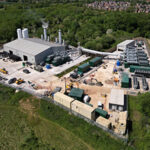
Distribution transformers play a vital role in the power sector. These transformers are in great demand with growing urbanization and mass rural electrification program of the government. They are the interphase between the LT consumers and the distribution utilities.
Types of distribution transformers
Liquid filled Transformers:
- Mineral Oil filled
- Natural & Synthetic Ester oil filled
Dry type:
- Resin cast
Types of core:
- CRGO (Cold Rolled Grain Oriented Steel)
- Amorphous core type
Theory
Distribution transformers work on the fundamental principle of electromagnetic induction. The basic components of all the transformers: they consist of either a core of high permeability silicon steel laminations or an amorphous core laminations. HV & LV windings are made of copper or aluminium conductors. The windings (pre-insulated with Kraft paper) are wrapped around the core. Press board is used for insulation wherever required. The magnetic core provides a path for flow of magnetic flux, which is developed when the voltage is applied on the HV side. The thickness of winding depends up on current carrying capacity vis-à-vis kVA rating. The HV & LV voltages enter the transformers and come-out of the transformers through the bushings of appropriate voltage rating.
Mineral oil-immersed transformers
The population of mineral oil-immersed distribution transformers is the largest due to mature and proven technology and classical optimum efficiency usually at around 50% load. Now-a-days the distribution transformers are so designed to deliver highest efficiency at higher loading say 75% for better asset utilisation.
The main tank of the transformer contains the core and winding assembly & filled with the mineral insulating oil. Besides providing vital insulation the mineral oil works as a cooling medium and diagnostic tool to monitor the health status of the transformer. The solid insulation and mineral oil form an inseparable insulation system in the transformer.
The reliability of liquid immersed transformers depends upon its insulation structure comprising of kraft paper wrapped around the winding conductors, pressboard and mineral oil.
These Transformers are more efficient than the dry-types and they usually have a longer expectancy life with proper maintenance & handling and also the oil is a more efficient cooling medium in reducing the hot-spot temperature in the winding – and provides a better over load capability.
By virtue of low flash/fire point it is prone to failure. Thus, proper monitoring of WT/OT is essential.
Mineral oil is not eco-friendly and is also hazardous for human beings, as it does not biologically degrade or disintegrate. It leads to hazardous waste generation – and hence cannot be disposed-off easily without affecting the environment. It is a long-term pollutant for the environment.
The mineral oil being a highly hygroscopic medium, readily absorbs moisture from air, which causes deterioration of its vital dielectric strength – depending upon the proportion of moisture absorbed. If the moisture content in kraft paper insulation doubles, the transformer life expectancy is immediately halved.
Mineral oil is the by-product of crude oil refining process, hence its availability will be difficult in near future due to depleting sources of natural petroleum – viz. crude oil, which cannot be replenished.
Ester oil-immersed transformers
Ester oil has been invented after regress research and development, which is eco-efficient for distribution transformers. They are natural ester oil (vegetable oil based) and synthetic organic ester oil as insulating liquid in lieu of mineral oil.
The constructional features of ester oil immersed transformers is similar to the mineral oil immersed transformers. (refer Fig.1).

The use of ester oils has found worldwide acceptance for advantages that they offer (refer Fig.2).

- Need for fire-fighting: From fire safety perspective, the ester oils are safer than mineral oils, as they are classified as ‘K Class fire hazard’ capable (fire temperature > 300 deg. C) in IS:13503 -2013/EC 61039-2008. The need for fire-fighting measures is reduced for the ester oil-immersed transformers. Even if the transformer catches fire, it would get extinguished soon due to the oil’s low calorific value. Due to higher flash point, an ester oil does not react heavily during any fault within the transformer. In absolute terms, total cost of damage resulting from ester oil-immersed distribution transformers is much lesser than that from mineral oil transformers, considering the repair costs and damage to the surroundings.The data of flash point and fire point for mineral oil and ester oil, reproduced from referred standards, has been furnished in the later part of this article under the heading ‘Comparison of Characteristics of Insulating Liquids’.
- Demerits of ester oil: As far as demerits are concerned, the ester oil has the tendency of getting oxidised more easily. During oxidation, the oil tends to form by products, such as acids and sludge, which may lead to faster ageing of the transformer due to adverse effect of oxidation on the cellulose kraft paper insulation. Hence, special care has to be taken while handling the ester oil to prevent it from exposure to atmospheric conditions. Hence, sealed type ester oil-filled transformers are preferred for their longevity and minimal need for oil replacement.
- Green transformers: The ester-oil immersed transformers are categorised as ‘green transformers’ as there is optimum use of eco-friendly materials that are biodegradable – and can be disposed-off without causing serious damage to the environment.
Cast resin (Molded epoxy resin)
In this type of transformers, the winding coils are solidly cast in resin under a vacuum in a mold. The manufacturing process locks the windings in a strong epoxy resin with high dielectric strength, protecting the transformer from severe operating environments.
As the cast resin insulation is resistant to fire and reliable even in extreme weather, these transformers are preferred in the chemical industries with hazardous and corrosive processes, on offshore locations and onboard the ships. They are preferred in nuclear plants, mining as the dry-type transformers have low fire hazard characteristics, they are considered in most installations, where the power distribution system requires utmost safety.
These transformers require lesser maintenance in comparison with the liquid-immersed transformers – and they are ideal in polluted environments.

Due to more losses, typical full load efficiency of the dry-type transformers is around 95%. The operating cost or life-cycle cost of the dry-type transformers is in general higher than that of liquid-immersed units.
It is impossible to recycle these types of transformers because of their construction. The entire winding of cast resin type is encapsulated in epoxy resin. The disposal of such transformers is carried out by burying underground. Hazards: it will spoil the landfill site and surroundings over a period of time due to its non-biodegradable characteristics.
As the surrounding air is the basic cooling medium, the dry-type transformers will be larger than liquid-immersed units for equivalent rating, but the first cost and installation cost would be less. When installed indoors, ventilation system needs to be sized for significant heat dissipation and provide proper cooling. These additional requirements increase the total cost of ownership of dry-type transformers.
Amorphous core distribution transformers
Amorphous Core Distribution Transformers (ACDTs) offer low loss design due to their cores made of amorphous alloy, used in lieu of conventional Cold Roll Grain Oriented (CRGO) silicon steel core. Amorphous steel comprises layers of thin foils of 0.025-0.03 mm thickness. Absence of a crystalline structure enables easy magnetisation – and being combined with low thickness & high electrical resistivity, it enables a significant reduction in no-load losses as compared to CRGO core. The winding in ACDT transformer is either of copper or aluminium. The mineral oil is used as the liquid insulation and cooling medium in ACDT. Core-coil assembly of an ACDT can be seen in Fig.4.

Due to the use of more efficient core material and low magnetizing current, the no-load losses are reduced. The temperature rise of these transformers is also low, which reduces losses. Thus, it is often preferred by utilities.
The ACDT distribution transformers show better tolerance to harmonics. This type of transformers is selected where loading fluctuations is pronounced and unpredictable.
However, their degradation of efficiency over time is more due to less capability of the brittle amorphous metal to withstand mechanical stresses. Once the small fragments of the amorphous metal are broken off, it is impossible to repair the core. Amorphous core material cannot be repaired or recycled upon burning of the transformer.
It is easy to over excite ACDT due to lower saturated flux of amorphous metal than CRGO, which lowers their overload capacity when compared to CRGO transformers.
As amorphous cores have a lower saturation point, they saturate at a lower flux density than CRGO, thus, larger winding coils and larger core are required for the same capacity and the ACDT require more footprint as compared to CRGO core transformers.
It may be noted that the finishing of the core assembly is very crucial for the amorphous core design, otherwise the noise level will be higher than the CRGO core transformers.
The cost of an ACDT transformer of the same capacity is generally more than that of a CRGO core transformer.
Comparison of characteristics of insulating liquids
Comparison of the important fire safety properties of insulating liquids is given in Table1, for reference.

Due to high viscosity, the ester oil is an effective coolant and reduces the heat developed by thermal stress.
The dielectric strength is not any way lower than that of mineral oil.
The fire safety characteristics of insulating liquids are compared in the graph given in Fig. 5, for better understanding.

Er.K. K. Murty possesses B.E.(Hons) Elec. Engg. He is an FIE, CE (India), Member-CGRE. He is a former Chief Engineer & HOD (Testing & Commun.), M.P. Power Transmission Co. Ltd. Jabalpur. He has worked as an Advisor (Testing) in SOUTHCO, Berhampur, Odisha (A DISCOM in Odisha (ADAG). He has also worked as Metering Consultant to M. P. Electricity Regulatory Commission, Bhopal. He was a Course Director for the Graduate Electrical Engineering Trainees, in the Training Institute of MPPTCL, Jabalpur. He was empanelled as an Expert Professional on the panel of CPRI, Bangalore and carried out third party inspection of power equipment on behalf of CPRI, Bangalore. Presently, he renders his services as a Sr. Visiting / Guest Faculty, for the in-house Training Institutions of the MPPTCL, Jabalpur and the M.P. East Zone, DISCOM, Jabalpur. He authored a book titled, “Compendium of Articles on EHV Substations & Protections for Budding and Practicing Engineers of Transmission Utilities.”



















